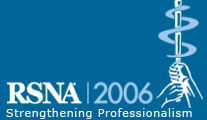
Abstract Archives of the RSNA, 2006
Peter Mildenberger MD, Presenter: Nothing to Disclose
Jörg Riesmeier PhD, Abstract Co-Author: Nothing to Disclose
Elmar C. Kotter MD, Abstract Co-Author: Nothing to Disclose
Michael Walz MD,PhD, Abstract Co-Author: Nothing to Disclose
Thomas Kauer, Abstract Co-Author: Nothing to Disclose
Marco Eichelberg MSc, Abstract Co-Author: Nothing to Disclose
DICOM-CDs are today very often in use for data interchange between hospitals and/or practitioners. Many of them reported problems with the quality of these CDs, esp. of lacking DICOM-Directories or other relevant informations. These experiences resulted in serious complaints by different medical organisations in Germany.
Therefore the German Roentgen Society (DRG) started a process to improve the quality of DICOM-CDs.
The initiative was supported by the DRG and most of the organisational and technical work was done by OFFIS (Oldenburg, Germany). The main objectives are:
1. clear specifications for DICOM-CDs
2. recommandations for vendors
3. recommandations for users
4. developing a test scenario for products
The papers were developed by some experts, and then brought into a public comment process for users and vendors.
Based on the specifications, first product tests will be done at the National Roentgen Congress in 2006.
The specifications are based on the DICOM standard and esp. on the IHE-PDI profile. This includes for example correction of lacking attributes, correct presentation of the DICOMDIR and some more. The recommandations for vendors include amongst others labeling of the CD or presenting all clinical relevant informations in DICOM format, e.g. using PDF (DICOM Suppl. 104)for clinical data. The recommandations for users incorporate the workflow aspects, e.g. using import procedures with DICOM worklist.
Some of these aspects or clarifications were brought to the IHE Technical committee and accepted for improvement on the IHE profile too.
The results of the first product tests in May 2006 will be presented.
Digital interchange of radiological informations is state of the art today, but acceptance can be jeopardized by insuffizent products. To improve the acceptance of DICOM-CDs the DRG has introduced a test procedure which is mainly based on DICOM and IHE-PDI.
Improvement of quality and workflow using DICOM-CDs based on IHE-PDI is possible.
Mildenberger, P,
Riesmeier, J,
Kotter, E,
Walz, M,
Kauer, T,
Eichelberg, M,
DICOM-CDs for Communicating Radiological Images—The DRG Approach for Improving Product and Workflow Quality. Radiological Society of North America 2006 Scientific Assembly and Annual Meeting, November 26 - December 1, 2006 ,Chicago IL.
http://archive.rsna.org/2006/4441558.html

